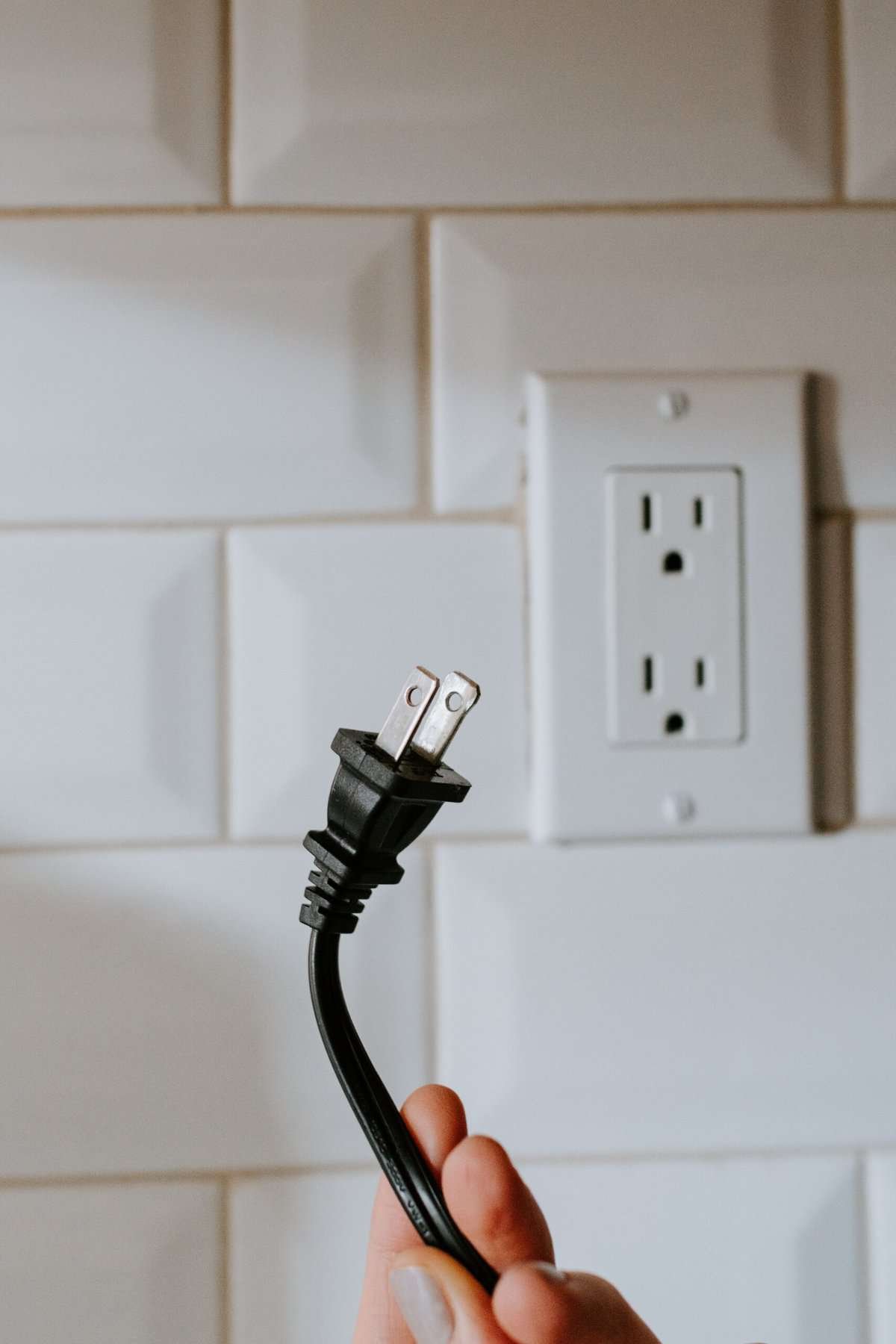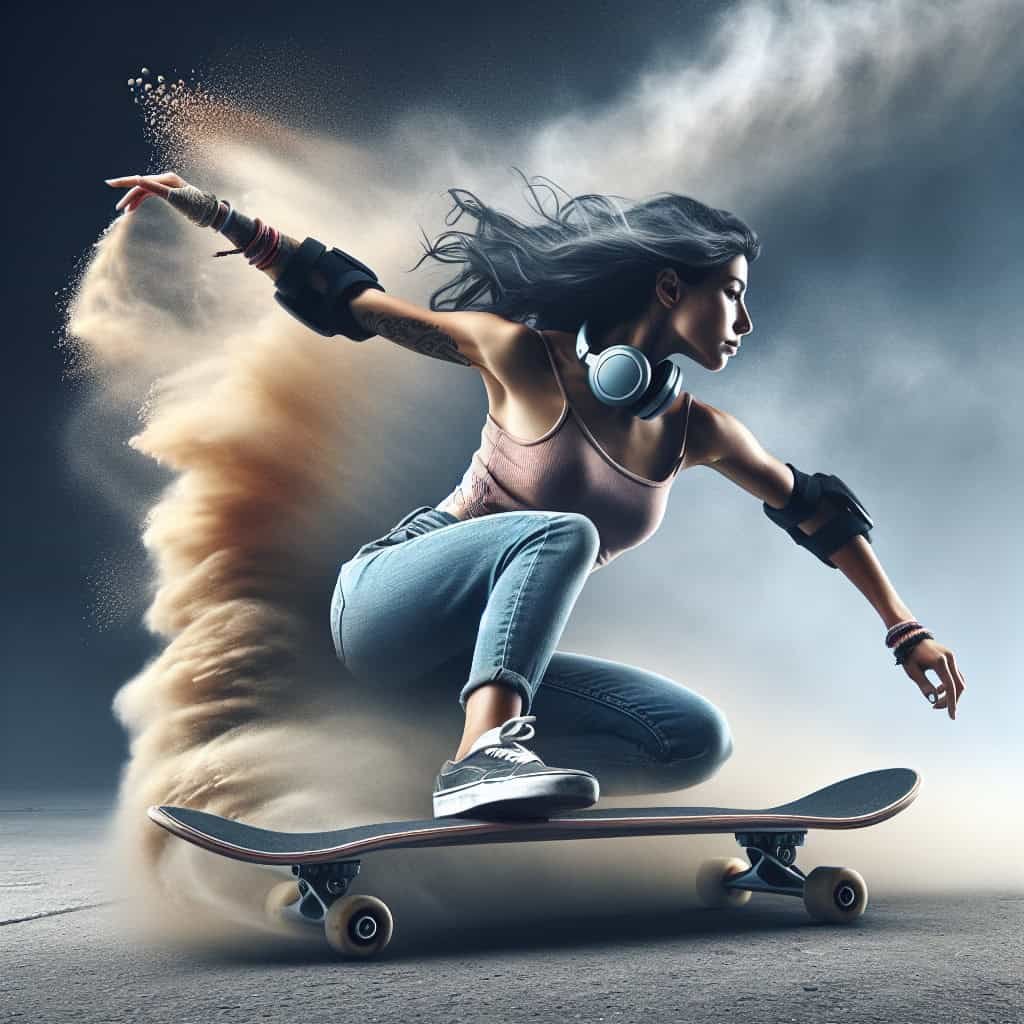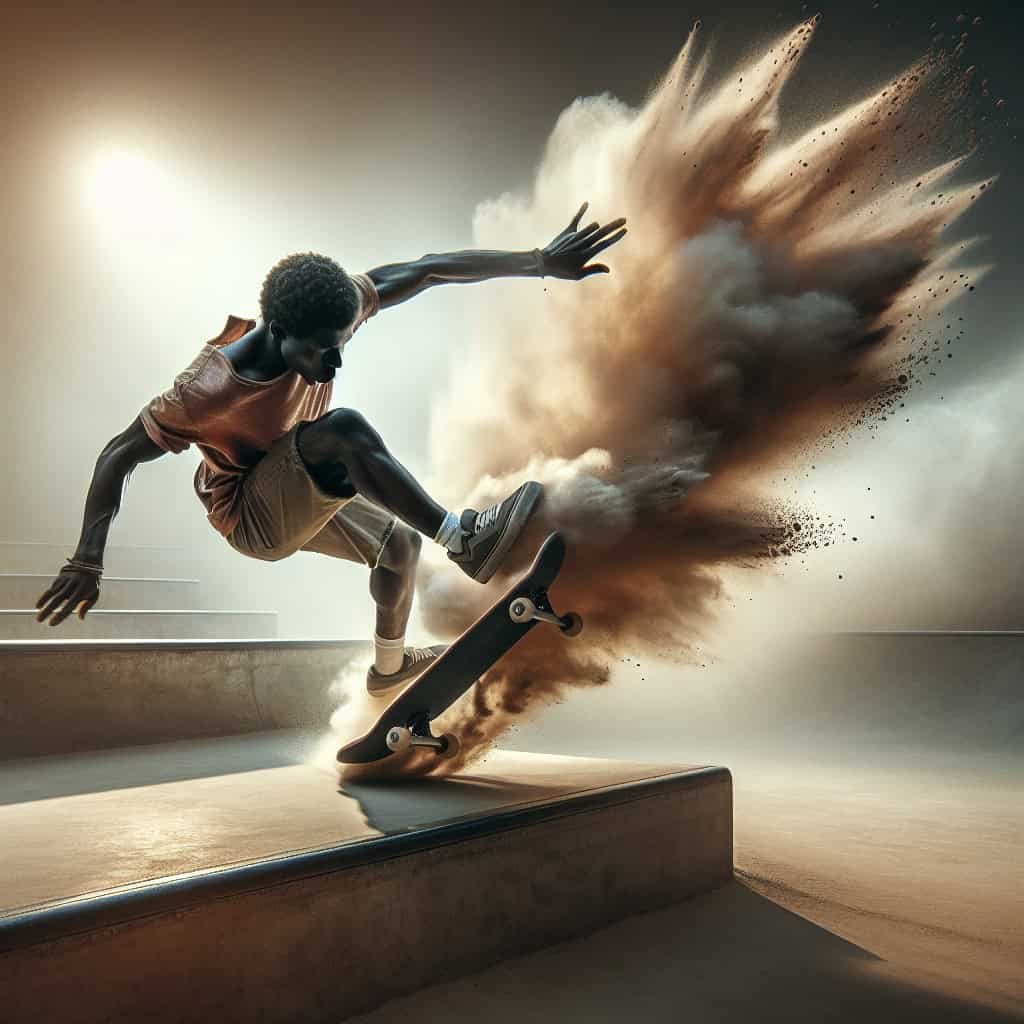If you’ve ever felt the exhilaration of gliding effortlessly on your skateboard while executing a powerful slide, then you know the sheer joy it brings. The freedom, the adrenaline rush, the feeling of mastering a trick that looks both effortless and impressive. But, like any skill, power slides require practice and finesse. So, if you’ve been wondering how you can take your skateboard power slides to the next level, fear not – this article is here to guide you on your journey to becoming a slide-slinging pro.
Body Positioning
When it comes to performing a powerful and stylish power slide on a skateboard, your body positioning plays a crucial role. The way you position your knees, distribute your weight, and place your arms can greatly impact your slide.
Knee Bend
To achieve a successful power slide, maintaining a slight knee bend is essential. This positioning allows for better control and stability during the slide. By keeping your knees slightly bent, you are ready to absorb any impact while maintaining balance on your board.
Weight Distribution
Proper weight distribution is another key component of executing a fantastic power slide. As you approach the slide, make sure to shift your weight to your back foot. This action will ensure that the majority of your weight is exerted on the rear wheels of your skateboard, allowing for a smoother and more controlled slide.
Arm Placement
While it may not seem as crucial, the positioning of your arms can contribute to your overall body stability and balance. Keep your arms comfortably extended in front of you, parallel to the ground, and slightly bent at the elbows. This positioning helps counterbalance your body, especially during quick turns involved in power sliding.
Foot Placement
The way you position your feet on the skateboard is another critical aspect to master for proficient power sliding. Understanding where to place your front and back foot can greatly affect your control and balance during the slide.
Front Foot Position
For power slides, your front foot should be positioned slightly angled, with the toes pointing towards the skateboard’s nose. Having your front foot at this angle allows for better control and stability while initiating the slide.
Back Foot Position
To maximize your potential for a powerful slide, your back foot plays a significant role. Place your back foot on the back end of the skateboard, perpendicular to the deck. This positioning helps you exert more pressure on the back wheels, enabling enhanced control and generating a longer slide.

Speed and Momentum
To execute smooth and impressive power slides, it is crucial to master speed and momentum management. Understanding how to generate speed and maintain momentum will greatly impact your ability to perform slides effortlessly.
Generating Speed
To generate sufficient speed for a power slide, you must have a solid understanding of pumping and weight shifting. Push your skateboard with one foot while simultaneously shifting your weight to your front foot. This action creates a wave-like motion, propelling you forward and increasing your speed. Find a balance between your footwork and weight distribution to maximize speed.
Maintaining Momentum
Once you’ve attained a considerable amount of speed, maintaining momentum is key to executing a lengthy and controlled slide. To do this, maintain a consistent and fluid pumping motion with both feet to sustain speed. Remember to keep your body relaxed and your weight distributed evenly to help maintain stability and momentum throughout the slide.
Choosing the Right Surface
The choice of surface for your power slides can greatly impact both the outcome and your overall experience. Being aware of the surface conditions and selecting the appropriate one will enhance your ability to execute flawless slides.
Smooth and Slick Surfaces
Opting for smoother and slicker surfaces will significantly contribute to the success of your power slides. Surfaces such as concrete, asphalt, or polished skate park ramps provide an ideal slickness that allows for smoother, longer, and controlled slides. The reduced friction on these surfaces facilitates easier initiation and maintenance of slides, ensuring a satisfying experience.
Avoiding Rough or Sticky Surfaces
While smooth and slick surfaces optimize power slides, it is important to avoid rough or sticky surfaces. Surfaces like rough pavement, gravel, or surfaces with debris can hinder your ability to slide effortlessly. These surfaces increase friction and may cause you to lose balance or traction, leading to a less controlled and shorter slide. Always evaluate the surface conditions carefully before attempting power slides.

Mastering the Technique
Mastering the technique of power slides requires practice, patience, and a deep understanding of the mechanics involved. Breaking down the process into three key stages – initiating the slide, balancing and control, and finally, the slide’s exit – will help you develop a more refined and elegant power slide.
Initiating the Slide
To initiate a power slide, shift your weight to your back foot while leaning slightly towards your heels. Engage your core and engage your back leg to generate tension, pressing down on the tail of the skateboard while twisting your shoulders and hips towards the direction of your slide. This torsion, combined with the pressure applied to your back wheel, will initiate the slide.
Balancing and Control
As you slide, maintaining a strong sense of balance and control is crucial. Your body weight should be evenly distributed between your front and back foot. Keep your eyes focused on the direction you want to slide, and use your arms to counterbalance any shifts or turns that occur during the slide. Continuously adjust your body position and weight distribution to maintain control and stability throughout the slide.
Exiting the Slide
Exiting the slide smoothly and with finesse is just as important as initiating it. To exit the slide, gradually shift your weight back to your front foot, reducing pressure on the tail of the skateboard. Maintain your balance and control, gradually turning your hips and shoulders back to their original position. This gradual transition ensures a seamless exit, allowing you to seamlessly transition into your next move.
Increasing Slide Duration
If you’re looking to extend the duration of your power slides, there are a few techniques and considerations to keep in mind. These tips will help you maintain a longer slide and showcase your skills even further.
Applying More Pressure
The amount of pressure you apply to your back foot can significantly impact the duration of your slide. Increase the pressure gradually to optimize the slide’s length. Be mindful not to exert too much force, as excessive pressure could lead to loss of control or even cause the wheels to lock up. Practice and find the right balance to maximize slide duration.
Tire and Wheel Considerations
Different tire and wheel compositions can also affect your power slide duration. Softer and wider wheels offer increased grip, making it more challenging to slide for longer periods. Conversely, harder and narrower wheels reduce grip, facilitating longer and smoother slides. Experiment with different wheel compositions and find the ones that suit your preferred slide duration.

Practice Makes Perfect
Like any skill, mastering power slides requires practice, commitment, and repetition. Consistently dedicating time and effort to honing your skills will undoubtedly yield improvement.
Finding a Suitable Location
Choosing an appropriate location to practice power slides is essential for both safety and skill development. Look for smooth and open surfaces, such as skate parks, empty parking lots, or designated areas for skateboarding. Ensure the location is free from obstacles, debris, and pedestrians, allowing you to focus solely on your technique.
Safety Precautions
Safety should always be a priority when practicing power slides. Wear proper protective gear, including a helmet, knee pads, elbow pads, and wrist guards. Familiarize yourself with the area’s traffic conditions and applicable laws or regulations. Always be aware of your surroundings and ensure that others are aware of your presence when practicing power slides.
Consistency and Repetition
Building muscle memory is crucial to perfecting power slides. Consistently practice the technique, focusing on the key elements of body positioning, foot placement, and momentum management. Repeat the process, gradually increasing speed and slide duration. By dedicating regular practice sessions, your skills will steadily improve, and your power slides will become more refined and controlled.
Advanced Techniques
Once you have mastered the fundamentals of power sliding, you can explore advanced techniques to further impress and challenge yourself. These techniques require an elevated level of skill and precision, but with practice, you can add more complexity to your power slide repertoire.
180 Power Slides
A 180 power slide adds a stylish and dynamic element to your slides. As you initiate the slide, add extra rotational momentum by twisting your hips and shoulders further. This action allows you to complete a 180-degree turn, facing the opposite direction at the slide’s conclusion. Mastering this technique requires enhanced balance, body control, and coordination, so take the time to perfect the basic power slide before attempting the 180 spin.
360 Power Slides
For the most skilled and daring riders, the 360 power slide showcases a high level of control and mastery. This technique involves executing a full 360-degree rotation while power sliding. It requires exceptional balance, coordination, and spatial awareness. Practice in a controlled and safe environment before attempting this advanced maneuver.
Combining with Other Tricks
Once you are confident in your power sliding abilities, challenge yourself to combine power slides with other tricks or maneuvers. Experiment with adding power slides to ramps, ramps, manuals, or even while performing ollies or kickflips. This creative integration of power slides with other tricks elevates your skateboarding skills and adds a unique flair to your riding style.

Learning from Others
Improving your power slide technique can also come from observing skilled riders and utilizing online tutorials and tips.
Observing Skilled Riders
Take the time to watch and observe experienced skateboarders executing power slides. Pay close attention to their body positioning, foot placement, and control. Analyze their techniques and try to replicate their movements. Emulate their style while incorporating your unique approach to develop your own signature power slide.
Online Tutorials and Tips
The internet provides a wealth of resources for learning and improving skateboarding techniques. Seek out reputable and reliable online tutorials, videos, and articles that focus specifically on power sliding. These resources can offer valuable insights, step-by-step instructions, and tips from experienced skateboarders. Apply the knowledge gained from these resources to refine and enhance your power slide technique.
Common Mistakes to Avoid
Avoiding these common mistakes can help you progress more efficiently and prevent potential setbacks.
Leaning Too Far Back
Leaning too far back during a power slide can lead to loss of control and cause your ride or slide to end abruptly. Keep your body balanced and centered throughout the slide, shifting your weight gradually as necessary. Focus on maintaining control and stability by continually adjusting your body position and distributing your weight evenly.
Lack of Confidence or Commitment
Confidence and commitment are key to performing successful power slides. Doubting yourself or hesitating can disrupt your flow and potential for a smooth slide. Trust your abilities, commit to the slide, and stay focused. Remember that practice makes perfect, so be patient with yourself and maintain a positive mindset.
Incorrect Foot Positioning
Improper foot positioning can severely impact your power sliding technique. It is crucial to place your front foot slightly angled with toes pointing towards the skateboard’s nose while keeping your back foot perpendicular to the deck. Inaccurate foot placement can hamper control, stability, and overall performance during power slides. Pay close attention to your foot positioning and make adjustments as necessary.
In conclusion, improving your skateboard power slides requires a combination of technique, practice, and a deep understanding of body positioning, foot placement, speed, and surface selection. Mastering the fundamentals while gradually advancing to more complex maneuvers will contribute to your growth as a skilled skateboarder. Dedicate time to practice, seek inspiration from others, and always prioritize safety. With determination and perseverance, you’ll soon be executing powerful slides that impress and inspire.

